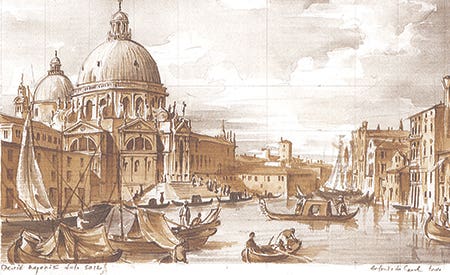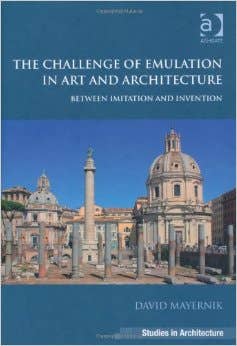
Features
The Challenge of Emulation in Art and Architecture


The Challenge of Emulation in Art and Architecture: Between Imitation and Invention
By David Mayernik
Ashgate Publishing Co., Surrey, England; Burlington, VT; 2013
246 pp; hardcover; $106.41
ISBN-13: 978-1409457671
Reviewed by Alvin Holm
As a timely response to a hot topic today, David Mayernik’s new book deftly puts to rest the question in architecture and art of “Imitation versus Invention” that currently vexes so many. And way beyond that satisfying appetizer, this rich feast has many more varied courses to enjoy over time. It is topical and historical. It is both personal and scholarly. And it is as much about learning as it is about teaching. Overall it is as much a joy to savor the erudition as it is to view the beautiful illustrations of old masters and the fine work of modern Mayernik himself.
First to the questions that currently ripple across the Internet. Does dependence on the Classical Orders stultify creativity? Or does the liberation of Modernism bring forth chaos? Expressed in dozens of other ways as well, this time-worn conflict is addressed in the first line of Mayernik’s Introduction. “The last two centuries of artistic and architectural polemic have been underpinned by an opposition between partisans of imitation and invention, with the latter certainly the dominant position for more than a half a century.”
He then briefly examines the broader historical record and swiftly comes to a graceful resolution of the argument so bitterly contested these days. Without rancor he manages to acknowledge the opposing ideas as both necessary components of a larger unity that transcends both when joined with Emulation. Mayernik’s exposition of this “ancient ideal of art based on a system of training… from imitation through emulation to invention” is clear, concise and thoroughly fascinating.
The case for Emulation is made quite convincingly within the Introduction itself. It is traced through the centuries both backwards and forward, and related laterally to art and architecture as well as to literary strategies and “ancient rhetorical theory.” Because of this comprehensive treatment the Introduction could very well stand on its own as a fully developed exposition of the book’s title and as such it is an essay in itself of great value to the re-emergence of the Classical Tradition in our time.
Beyond the masterful Introduction, the book consists of nine excellent chapters, all richly illustrated and each an expansive examination of Imitation, Emulation, and Invention in various eras across the spectrum of all the arts, often including literature, music and drama as well. Each chapter is a delightful journey and a fascinating foray into historical practice and ideals, and always with implicit or direct reference to our own time.
This special quality of immediacy is seldom found in scholarly writing. Here it certainly derives Mayernik’s own experience as an architect and as an artist, as a student and a scholar, and as a writer and teacher himself.
The first sentence we read in the book sets the stage. The Preface begins with “A book about emulation cannot help but be emulative itself.” He goes on to say how he has been shaped as an artist “by the books he has read on the history of art and architecture,” and by the historian/writers he has known as well as by ”those artists and architects, precious few, whom I have known and who have pushed me to higher standards... ”
This book then is not only a work of admirable erudition but it is also a personal testimony.
It is a rich review of 2500 years of the Classical Tradition. And it is also a demonstration through his own masterful works of how he has himself learned and how he has come to teach.
Among many other important issues of today that Mayernik addresses head-on is beauty, a word little heard in fine art circles these days and scarcely uttered in schools of art and architecture. He says quite simply: “Emulation was a means to achieve Beauty.” (Note the capital B.) And he goes on to say “Beauty in its absolute transcendent sense was the end to which all artists aspire, and Emulation of rivals was a way to get there.”
This “rivalry” was of a very cordial sort where you first imitate the master you admire in order to learn how he achieved success and then you seek to go beyond and get closer to the ideal you both are trying to reach. This is the rivalry Mayernik explains as Emulation. Significantly he states that “Only if a culture could have a rational conversation about Beauty, even if it involved debate, could artists engage in a game of emulation that had any relevance or meaning to an audience beyond themselves.” In developing this point he maintains “we have to accept the idea that Beauty can be discussed objectively…. It is present in things, not in the eye of the beholder.” This brave assertion affirms an ancient belief and restores it to currency (we hope).
Mayernik states his case at the outset. He ranges far and wide in fascinating exploration of eras and artists, and he ends by saying it again:
“We need not be trapped between stultifying imitations and self-consuming creativity, each of which is ultimately circular. Emulation is a way out of cultural conflict, and a way into a more instructive engagement with the past. Recovering its forgotten role in history is the beginning of understanding its relevance today.”
This book, like a definition of tradition itself, is set squarely in the present, looks deeply into the past with rare illumination, and confidently guides us to a beautiful future. TB
Alvin Holm, AIA, is the founding principal of Alvin Holm AIA Architects of Philadelphia, PA, a full-service general practice architectural studio specializing in traditional design in the Classical manner.








